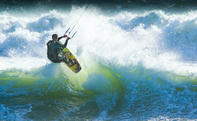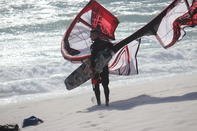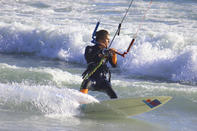There may not be much we can teach you when it comes to lazing about on a cruise catamaran, but wind sports such as kitesurfing (or kiteboarding as it’s also known) are a completely different matter.

Although this extreme activity has been around for around thirty years, it was only during the past decade that the sport was popularised.
The first attempts at kitesurfing in the 70s involved paragliding wings and surfboards, and it was only with the invention of the inflatable kite in 1987 that it could be termed a developing sport.
Now it was easy enough to relaunch your kite from the water, and wakeboards enabled bi-directional travel. It wasn’t long before the first competitions took place in Maui, and these days the international circuit is a completely different…erm, board game.
Getting the Kit

A quad (or four-line) kite forms the basis of your kit, and you operate it using a control bar and a set of high-tensile lines. The kite size ultimately depends upon your weight, skills levels and wind strength, but you will need a range of kites for varying conditions. Treat your kite well (a freshwater rinse after a session is good, and never store it wet) and it should last for four or five years without a problem.
The board itself is based on a bi-directional design with foot straps and a leash, and the shape and size determines its suitability for specific water conditions. Bigger and wider board make for easy rookie riding, and in addition you’ll need a harness, PFD, helmet and a good neoprene wetsuit (this is a must in the freezing Cape waters).
Expect to spend mega on a harness and wetsuit; a board and on the kite itself. Although kitesurfing gear in South Africa is relatively affordable, you might save a few Rand if you shop online. Buying used equipment when you start off is a good idea.
Learning the Ropes

Kitesurfing is not nearly as difficult to master as it looks from the beach and a good instructor should have you defying gravity within three to four intensive sessions. Personal instruction is undoubtedly the best way to get into the sport, as there will be no need to invest in expensive equipment in order to get airborne.
While you’re learning the ropes, you will gain an excellent idea as to which boards, harnesses and kites work best for you, plus you will be gaining experience within a relatively controlled environment. Like any other adrenaline sport, kitesurfing is inherently dangerous, and it is therefore best to learn from the experts. Not only will you avoid hurting yourself and innocent bystanders, but you will also minimise the chances of serious damage to equipment.